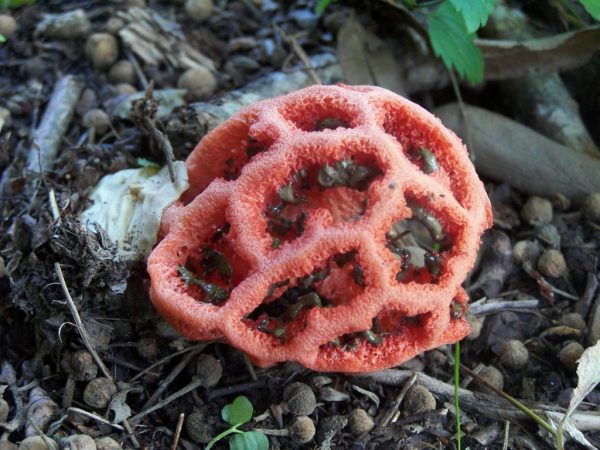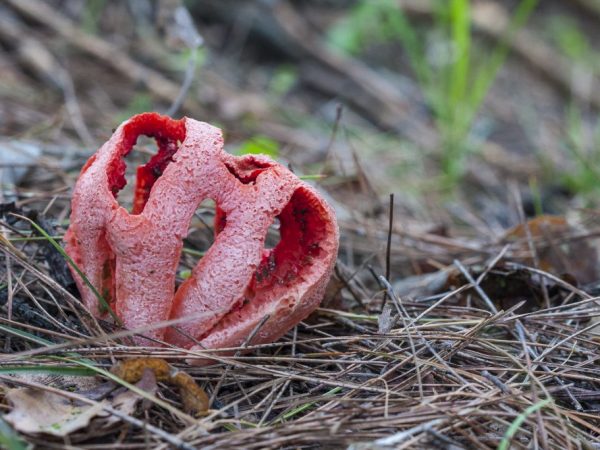Features of the red trellis mushroom
Among the variety of forest gifts, there are representatives that are very unusual in appearance, to which the red trellis mushroom belongs.

Features of the red trellis mushroom
Description
The red lattice is listed in the Red Book of Russia. Its Latin name is Clathrus ruber. It belongs to the class Agaricomycetes, the Veselkovy family.
The red lattice is found in the southern regions of the country, and this species is also quite widely known in the Mediterranean countries. It has the following description:
- young fruiting body, round or ovoid;
- height - up to 6-7 cm;
- diameter - up to 4.5-5 cm;
- the outer shell is whitish;
- the second layer of the membrane is mucous;
- spore mass of olive color;
- the receptacle of the mature fruiting body is coarse-celled, with a reticular structure, closed.
The outer shell of a mature organism bursts, forming blades resembling the rays of a star, and the mushroom at this moment looks like a space alien. It forms a spherical lattice, bright scarlet, with many cells, similar in shape to a honeycomb. The size of the mushroom reaches 8-10 cm in diameter and up to 13 cm in height.
The inner surface of the recipe is covered with smelly mucus - this is a fertile gleb with a spore mass located on it. The smell of rot, sharp and unpleasant for humans, serves as a bait for insects, which successfully spread the spores of the red clathrus.
The fungus is able to withstand small frosts, down to -5 ° C, therefore Clathrus ruber is found more often in the countries of the Mediterranean coast. It grows in groups in more humid and hotter climates.
Related species
Red trellis belongs to inedible mushrooms. In the climatic conditions of Russia, it has no edible counterparts. The inedible and conditionally edible species that are part of the Veselkovy family include:
- florist Javanese;
- Archer's florist;
- canine mutinus;
- mutinus Ravenelli.
Javanese florist
Javanese flower bollard is an inedible mushroom listed in the Red Book. In appearance, the fruit body resembles a cigar or spindle, consists of 3-8 parts (blades).
The color in young organisms is whitish, in older ones it is orange-red. The body stands on a low, hollow leg. On the inner side of the blades, there is an olive-colored slimy gleb. The inner side and sides of the "blades" are wrinkled. The Javanese florist species has a pungent odor, on which insects flock and carry spores for many kilometers.
It is more commonly found in Australia, North America, New Zealand and Africa. He loves a warm, even hot climate. They prefer humus-rich soil on the outskirts of the forest, it is a saprophyte.
Archer's Flower Breeder

The mushroom has an unpleasant odor
Another inedible species is Archer's (Arger) flower stalk. His homeland is Australia. In France, it was first seen in 1814. In the rest of Europe, it appeared only in the 19th century. The name was given in honor of the scientist-mycologist W. Archer.
It has the following description:
- pear-shaped fruit body;
- the diameter of the fruiting body is 5-6 cm;
- mycelium hyphae are long, located at the base;
- peridium is whitish, with a gray tint;
- the recipe develops after the rupture of the outer shell;
- no legs;
- the inner surface of the recipe is spongy;
- the smell is pungent, unpleasant.
The recipe, when bursting, becomes similar to tentacles, and the shape of the entire mushroom immediately becomes star-like and reaches 15-16 cm in diameter. The wrinkled inner surface is covered with greenish spots - spore-bearing gleba. The blades have a delicate brittle pulp. The spores are medium in size (in terms of microscopic size), in the form of narrow cylinders, olive or green in color. A young organism is sometimes confused with an ordinary veselka.
The smell, unpleasant for the human sense of smell, attracts small insects that help the body spread, carrying its spores in different directions.
Irina Selyutina (Biologist):
Archer's flower breeder is characterized by orange-red lobes of the fruiting body, which in a mature specimen separate at the top and spread out like a star, can settle not only on rotting wood or humus soil, but also on the sands of deserts or semi-deserts. On the territory of the former USSR, it was found in the Aktobe region (Kazakhstan) on the sands among thickets of willows.
This saprophyte occurs in deciduous or mixed forests from July to October. Rarely grows on sandy soils.
A strong unpleasant smell warns that the mushroom is inedible, its pulp is tasteless.
Canine mutinus
One of the related species of trellis is the canine mutinus. It forms fruiting bodies from mid-summer to late October in North America and European countries.
Its description:
- the shape of the fruit body is oval;
- diameter - up to 3.5 cm;
- height - up to 20 cm;
- the color of the spore-bearing gleb is light green;
- the surface of the gleb is cellular.
The surface of the recipe has a dull red tint, the pulp smells unpleasant when broken. Fruiting begins in July and ends in late October. The fungus settles in humus-rich soil and is a saprophyte.
Irina Selyutina (Biologist):
Canine mutinus is a typical forest species that is found mainly in broadleaf forests on humus-rich soil. It can also be found in coniferous forests among thickets of bushes, sometimes around rotting tree trunks, but only in wet places. The young fruiting body is usually white, ovoid or oval in shape, reaching a diameter of 3-4 cm. The white peridium (shell) is torn by 2-3 lobes and remains at the base of the fruiting body. The growing recipe (sterile part) is colored in the upper part, pointed and goes into the head. The head is thin - no thicker than the base of the receptacle and is covered with an olive-colored mucous membrane on top.
Canine mutinus grows in families. It is only necessary to collect (as in the case of the vestka) specimens that are in an egg-shaped, non-bursting shell. After it bursts, the glebe quickly dissolves into an unpleasant, but very attractive mass for insects. Insects attracted by its specific "aroma" carry spores over long distances from the parent organism, which contributes to the dispersal of the fungus. After 3-4 days, not a trace remains of the whole mushroom.
Benefit and harm
The red lattice is a rare species, so it is not used as a raw material for the production of medicines.
It is not poisonous. Perhaps, in the distant past, our ancestors used it for food - no one will undertake to assert this.
It rarely gets into food, due to an unpleasant odor, therefore food poisoning arising from a specific composition is not numerous. If this happens, poisoning will manifest itself with severe vomiting and diarrhea.The toxic effect disappears in a few hours without the intervention of doctors, if you drink enough liquid to prevent dehydration.
The whimsical shape attracts designers who use the organism's appearance to create intricate landscapes and contrast on summer lawns.
All its related species have no nutritional value.
Canine mutinus is extremely rare, therefore its edibility is conditionally determined. It is protected by law, it is prohibited to collect.
Conclusion
The number of myceliums of rare red and other types of trellis decreases every year. These amazing creations of nature require protection and human attention. Do not stomp on them because of the unpleasant smell, because everything in nature is interconnected.



